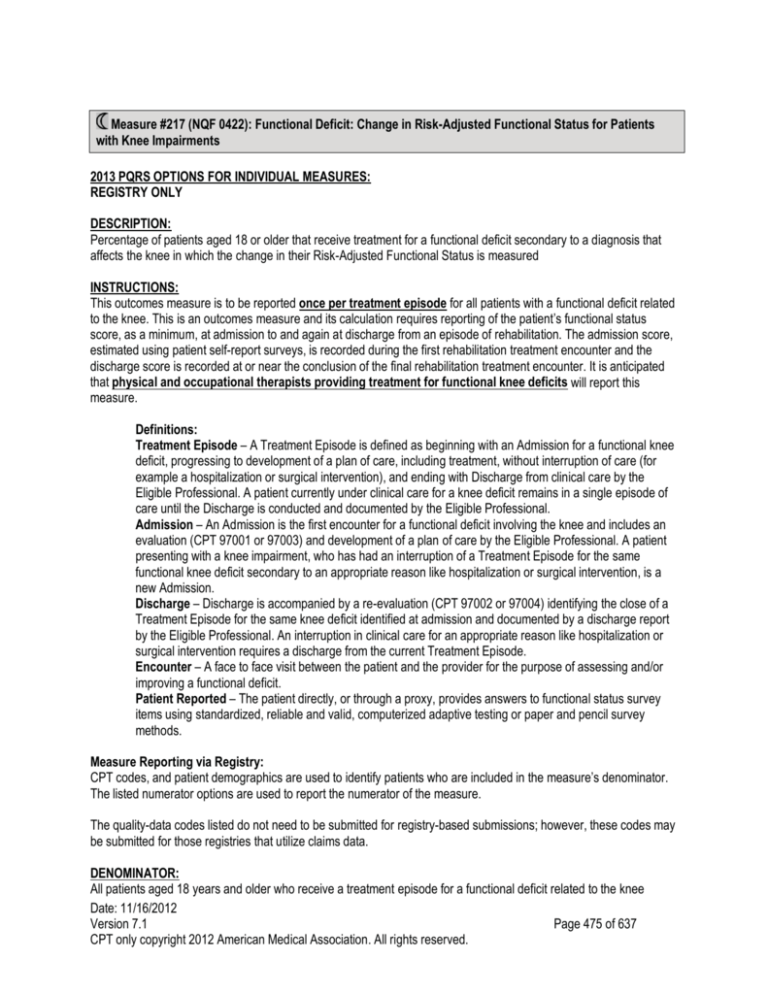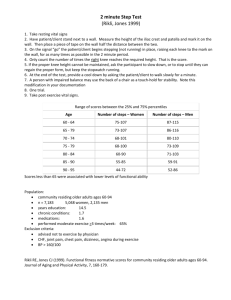
Measure #217 (NQF 0422): Functional Deficit: Change in Risk-Adjusted Functional Status for Patients
with Knee Impairments
2013 PQRS OPTIONS FOR INDIVIDUAL MEASURES:
REGISTRY ONLY
DESCRIPTION:
Percentage of patients aged 18 or older that receive treatment for a functional deficit secondary to a diagnosis that
affects the knee in which the change in their Risk-Adjusted Functional Status is measured
INSTRUCTIONS:
This outcomes measure is to be reported once per treatment episode for all patients with a functional deficit related
to the knee. This is an outcomes measure and its calculation requires reporting of the patient’s functional status
score, as a minimum, at admission to and again at discharge from an episode of rehabilitation. The admission score,
estimated using patient self-report surveys, is recorded during the first rehabilitation treatment encounter and the
discharge score is recorded at or near the conclusion of the final rehabilitation treatment encounter. It is anticipated
that physical and occupational therapists providing treatment for functional knee deficits will report this
measure.
Definitions:
Treatment Episode – A Treatment Episode is defined as beginning with an Admission for a functional knee
deficit, progressing to development of a plan of care, including treatment, without interruption of care (for
example a hospitalization or surgical intervention), and ending with Discharge from clinical care by the
Eligible Professional. A patient currently under clinical care for a knee deficit remains in a single episode of
care until the Discharge is conducted and documented by the Eligible Professional.
Admission – An Admission is the first encounter for a functional deficit involving the knee and includes an
evaluation (CPT 97001 or 97003) and development of a plan of care by the Eligible Professional. A patient
presenting with a knee impairment, who has had an interruption of a Treatment Episode for the same
functional knee deficit secondary to an appropriate reason like hospitalization or surgical intervention, is a
new Admission.
Discharge – Discharge is accompanied by a re-evaluation (CPT 97002 or 97004) identifying the close of a
Treatment Episode for the same knee deficit identified at admission and documented by a discharge report
by the Eligible Professional. An interruption in clinical care for an appropriate reason like hospitalization or
surgical intervention requires a discharge from the current Treatment Episode.
Encounter – A face to face visit between the patient and the provider for the purpose of assessing and/or
improving a functional deficit.
Patient Reported – The patient directly, or through a proxy, provides answers to functional status survey
items using standardized, reliable and valid, computerized adaptive testing or paper and pencil survey
methods.
Measure Reporting via Registry:
CPT codes, and patient demographics are used to identify patients who are included in the measure’s denominator.
The listed numerator options are used to report the numerator of the measure.
The quality-data codes listed do not need to be submitted for registry-based submissions; however, these codes may
be submitted for those registries that utilize claims data.
DENOMINATOR:
All patients aged 18 years and older who receive a treatment episode for a functional deficit related to the knee
Date: 11/16/2012
Version 7.1
Page 475 of 637
CPT only copyright 2012 American Medical Association. All rights reserved.
Option 1 – Physical Therapy Denominator Criteria (Eligible Cases):
$OOSDWLHQWVDJHG\HDUVRQGDWHRIHQFRXQWHU
AND
Patient encounter during the reporting period identifying evaluation (CPT): 97001
AND
Patient encounter during the reporting period identifying re-evaluation (CPT): 97002
AND
Functional deficit affecting knee
OR
Option 2 – Occupational Therapy Denominator Criteria (Eligible Cases):
$OOSDWLHQWVDJHG\HDUVRQGDWHRIHQFRXQWHU
AND
Patient encounter during the reporting period identifying evaluation (CPT): 97003
AND
Patient encounter during the reporting period identifying re-evaluation (CPT): 97004
AND
Functional deficit affecting knee
NUMERATOR:
Patients presented FOTO’s Functional Intake Survey for the Knee at admission and FOTO’s Functional Status
Survey at discharge for the purpose of calculating the patient’s Risk-adjusted Functional Status Change Residual
Score
Definitions:
Patient’s Functional Status Score – A functional status score is produced when the patient completes the
FOTO functional status survey (either by paper and pencil or computerized adaptive testing administration).
The functional status score is continuous and linear. Scores range from 0 (low function) to 100 (high
function). The survey is standardized, and the scores are validated for the measurement of function for this
population.
Patient’s Functional Status Change Score – A functional status change score is calculated by subtracting
the Patient’s Functional Status Score at Admission from the Patient’s Functional Status Score at Discharge.
Predicted Functional Status Change Score – Functional Status Change Scores for patients are risk
adjusted using multiple linear regression methods that include the following independent variables: Patient’s
Functional Status Score at Admission, patient age, symptom acuity, surgical history, gender, number of comorbidities and level of fear-avoidance. The Patient’s Functional Status Change Score is the dependent
variable. The statistical regression produces a Risk-Adjusted Predicted Functional Status Change Score.
Risk-Adjusted Functional Status Change Residual Score – The difference between the raw non-riskadjusted Patient’s Functional Status Change Score and the Risk-Adjusted Predicted Functional Status
Change Score (raw minus predicted) is the Risk-Adjusted Functional Status Change Residual Score, which
is in the same units as the Patient’s Functional Status Scores, and should be interpreted as the unit of
functional status change different than predicted given the risk-adjustment variables of the patient being
treated. As such, the Risk-Adjusted Residual Change Score represents Risk-Adjusted Change corrected for
the level of severity of the patient. Risk-Adjusted Residual Change Scores of zero (0) or greater (> 0) should
be interpreted as functional status change scores that were predicted or better than predicted given the riskadjustment variables of the patient and risk-adjusted residual change scores less than zero (< 0) should be
interpreted as functional status change scores that were less than predicted given the risk-adjustment
Date: 11/16/2012
Version 7.1
CPT only copyright 2012 American Medical Association. All rights reserved.
Page 476 of 637
variables of the patient. Aggregated Risk-Adjusted Residual Scores allow meaningful comparisons amongst
clinicians or clinics.
Not Eligible/Not Appropriate – A patient is not eligible if one or more of the following conditions exist:
x Patient refused to participate
x Patient unable to complete the questionnaire due to blindness, illiteracy, severe mental incapacity
or language incompatibility and an adequate proxy is not available
x Prior to conclusion of Plan of Care, intervention was interrupted or discontinued for any reason
including by the referring physician, the provider, the payer or the patient, and attempts by the
provider to complete a follow-up functional status survey near Discharge were unsuccessful.
OR
Numerator Options:
Risk-Adjusted Functional Status Change Residual Score for the knee successfully calculated and the score
was equal to zero (0) or greater than zero (> 0) (G8647)
OR
Risk-Adjusted Functional Status Change Residual Score for the knee successfully calculated and the score
was less than zero (< 0) (G8648)
Risk-Adjusted Functional Status Change Residual Scores for the knee not measured because the patient
did not complete FOTO’s Functional Intake on admission and/or follow up Status Survey near discharge,
patient Not Eligible/Not Appropriate (G8649)
OR
Risk-Adjusted Functional Status Change Residual Scores for the knee not measured because the patient
did not complete FOTO’s Functional Intake on admission and/or follow up Status Survey near discharge,
reason not given (G8650)
RATIONALE:
Functional deficits are common in the general population and are costly to the individual, their family and society.
Improved functional status has been associated with greater quality of life, self-efficacy, improved financial well-being
and lower future medical costs. Improving functional status in people seeking rehabilitation has become a goal of the
American Physical Therapy Association. Therefore, measuring change in functional status is important for providers
treating patients in rehabilitation and can be used to assess the success of treatment and direct modification of
treatment.
Change in functional status represents the activity domain of the International Classification of Function. If treatment
is designed to improve the functional deficit, it is logical to assess functional status at discharge using a standardized
score to determine if treatment improved the functional status of the patient over the treatment episode.
The National Quality Measures Clearinghouse has approved the measurement of change in functional status, using
this survey. (NQMC-1873)
CLINICAL RECOMMENDATION STATEMENTS:
The American Physical Therapy Association (APTA), in their Guide to Physical Therapy Practice, described five
recommended elements of patient management: examination, evaluation, diagnosis, prognosis and intervention. The
elements were intended to direct therapists in their approach to patient treatment for the purpose of optimizing patient
outcomes. The APTA clearly indentifies functional status data as one of the major forms of data to be collected for
patients receiving rehabilitation. The functional status measures should be used to assist in the planning,
implementation and modification of treatment interventions and should be used as measures of outcomes. The
current functional status scores can be used by therapists to fulfill the recommended methods of the APTA in the
management of patients in rehabilitation.
Date: 11/16/2012
Version 7.1
CPT only copyright 2012 American Medical Association. All rights reserved.
Page 477 of 637





